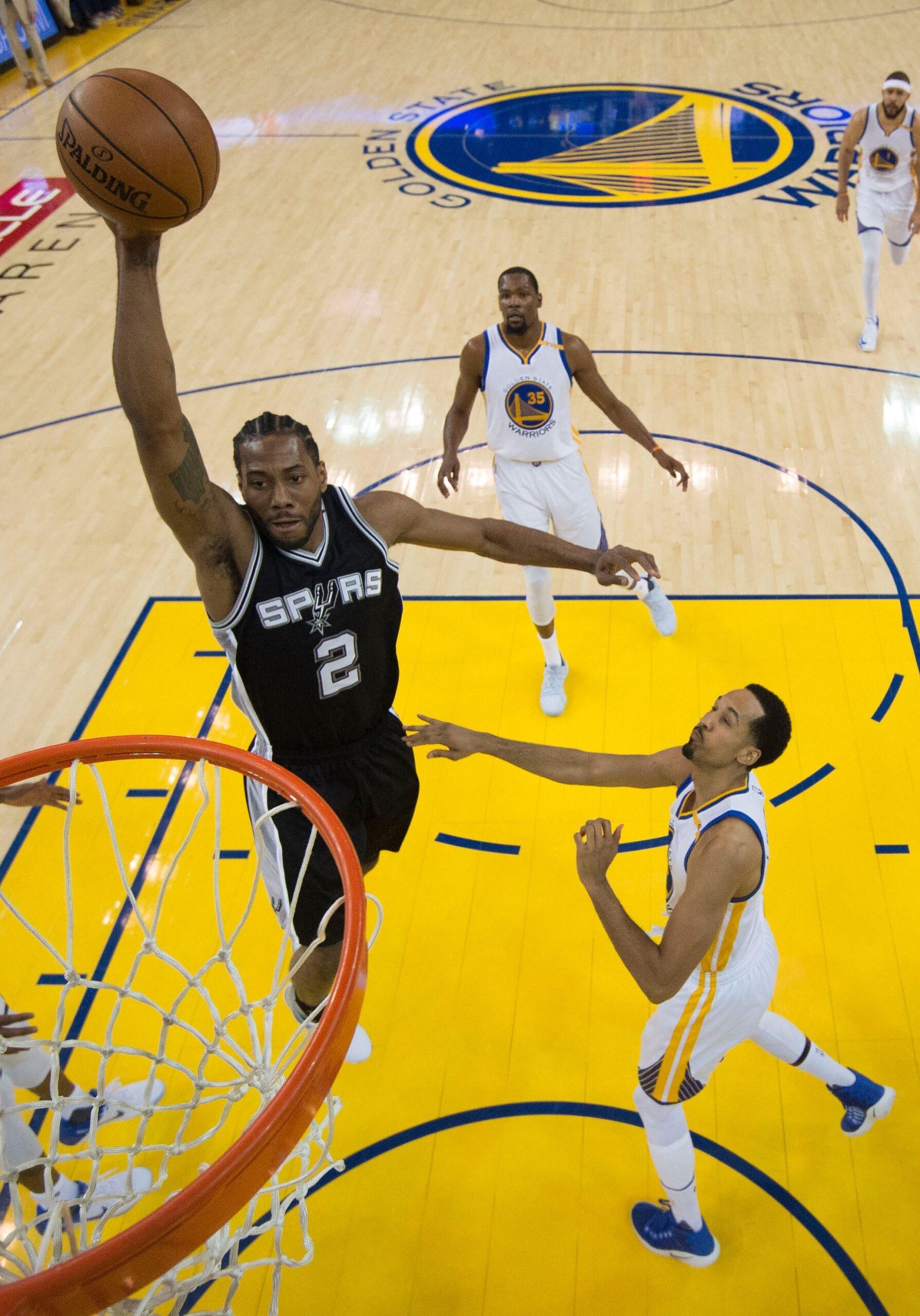One of the craziest offseasons in recent history has not only shaken up the league’s hierarchy, it’s altered the path for several prominent teams and players heading into the 2017-18 season. For Golden Opportunity Week, the third of four weeklong series leading up to the tipoff of a new NBA year, we’re taking long, hard looks at the most intriguing situations in the league—and what comes next for everyone involved.
The Spurs are back to their old tricks. Unlike the past two summers, they didn’t sign a big-name free agent. They were the only contender not involved in the offseason arms race. Their biggest acquisition was Rudy Gay, a 31-year-old coming off an Achilles tear. In the superteam era, they are betting big on continuity and internal improvement. The Spurs need their next generation of young players to take a big step forward. The most exciting things in San Antonio are happening under the surface. The Spurs are returning to their roots when it comes to team-building, but they are building a completely different style of team. The Spurs were one of the last holdouts resisting the leaguewide trends toward small-ball. This offseason, they shifted course.

Don’t let their progressive reputation fool you. When it comes to style of play, San Antonio is one of the most conservative teams in the league. While the Spurs pioneered taking the corner 3, the league has passed them by when it comes to offensive innovation. None of the Gregg Popovich disciples who have spread throughout the NBA run an offense like his. San Antonio was the exact opposite of Houston last season. The Spurs were fourth in the league in post-ups (9.3 percent of their offense), and they averaged more midrange shots (24.7) than 3s (23.5) per game. Popovich lived with a relatively inefficient offense so he could play lineups with two traditional big men that smothered opposing teams. His system is built on chasing opponents off the 3-point line and protecting the paint without fouling. The results speak for themselves. The Spurs had the no. 1–rated defense in the NBA each of the past two seasons, and they won an average of 64 games.
The limits to that style of play become obvious only in the playoffs. A team without lineup flexibility doesn’t have a Plan B if Plan A isn’t working. Oklahoma City upset San Antonio in 2016 by beating the Spurs at their own game. The Spurs’ older big men couldn’t hang with Steven Adams and Enes Kanter. The two giants weren’t unbeatable. San Antonio just didn’t have a small-ball lineup that could run the pairing off the floor like Golden State did in the Western Conference finals. Popovich changed that up last season, when he made some key adjustments following the Spurs’ blowout loss to the Rockets in Game 1 of their second-round series. He split up LaMarcus Aldridge and Pau Gasol and used lineups with a 6-foot-6 wing (Jonathon Simmons) at the 4. Popovich turned the tables on Mike D’Antoni. Houston power forward Ryan Anderson can hold his own against a team that attacks him in the post, but there was nowhere to hide him on defense when the Spurs went small against him.
San Antonio seems to have taken the lesson to heart. The Spurs have only three traditional big men on their roster—Aldridge, Gasol, and Joffrey Lauvergne, whom they signed to a two-year contract at the veteran minimum. Their top four big men last season—Aldridge, Gasol, David Lee, and Dewayne Dedmon—combined to average 94 of the 96 minutes available at the two frontcourt positions. The Spurs have more room to experiment with small-ball lineups now. Dedmon and Lee are gone. Aldridge and Gasol will start together, but they are a year older so their playing time will be rationed even more. They will each be in lineups as the only big man. When they are both out, the Spurs can play five guys who can shoot 3s and make plays off the dribble.
Playing smaller is inevitable when teams get younger. Few frontcourt players under 25 even know how to play in a two-post offense. Kyle Anderson and Davis Bertans, Lee and Dedmon’s replacements, are more comfortable at the 3-point line than in the paint. Anderson was a point forward in college. The logjam in the San Antonio frontcourt forced him to play on the wings in his first three seasons in the league, where his lack of foot speed makes him less effective. Anderson should be better going against slower players at the 4. Bertans, a second-round pick in 2011 who came over to the NBA last season, flashed an intriguing skill set as a rookie. He’s a 6-foot-10 player who gets up 3s quickly (he averaged 7.7 3-point attempts per 36 minutes of playing time last season) and plays above the rim (block rate of 2.8 percent). Personnel dictates style in the NBA. The more minutes those two guys play upfront, the more the Spurs will play offense like the rest of the league.

The other big change they could make is moving Kawhi Leonard to the 4. It’s hard to know how San Antonio plans to use him this year since he is sitting out the preseason with a thigh injury, but changing his position would soak up some of the available frontcourt minutes. He has the size (6-foot-7 and 230 pounds with a 7-foot-3 wingspan) to do it. Kawhi can rebound and block shots like a bigger player, and he would be an even bigger mismatch at the 4 than the 3. It’s a move many wings make. Carmelo Anthony is the starting 4 in Oklahoma City. LeBron James and Kevin Durant played as 5s for stretches of the NBA Finals.
Sliding Kawhi up a position would also create more playing time on the wings. Gay, if his recovery goes well, will get minutes at both forward spots. He is big enough (6-foot-8 and 230 pounds with a 7-foot-3 wingspan) to still be an effective scorer even if he loses a step. The biggest adjustment for him will be moving the ball more often. He has averaged fewer assists (2.3 per game) than turnovers (2.4) in his career. Like a lot of primary scorers on bad teams, Gay could get a second wind as a bench scorer on a good one. He has never played with anyone like Kawhi. Playing them together at the 3 and 4 will make San Antonio a better matchup with small-ball teams in the playoffs.
Dejounte Murray, the starting point guard until Tony Parker returns from a torn quad, fits their new style. Length on the perimeter makes it easier to play small upfront. At 6-foot-5 and 170 pounds with a 6-foot-9 wingspan, Murray is a supersized 1 with elite athleticism who can stuff the stat sheet. As a rookie, he had per-36-minute averages of 4.7 rebounds, 0.7 blocks, and 0.9 steals per game. Playing him with more frontcourt shooting creates driving lanes for him. Murray isn’t a shooter. He shot 28.8 percent from 3 in college and attempted only 23 3s last season. Having him walk the ball up the floor and enter it in the post is not the best way to use him. Murray slipped to the no. 29 pick in the 2016 draft because of poor shooting and careless play in his only season at Washington, but he just turned 21 so he’s still young enough to be molded. While most guys like him don’t fix their bad habits at the next level, San Antonio thinks he can be an exception. The Spurs carefully vet players before the draft, and their veterans rave about his work ethic.
The Spurs will have some interesting lineups this season. They still have Danny Green, one of the best 3-and-D wings in the league, as well as Patty Mills and Manu Ginobili anchoring their second unit. Pair some combination of those three and Parker, Murray, Kawhi, Gay, Anderson, and Bertans, and they can play small ball with any team in the NBA. That doesn’t even count Derrick White (the no. 29 pick in this year’s draft) and Bryn Forbes (an undrafted free agent in 2016 who was a summer league standout). San Antonio can find players anywhere. The Spurs found Simmons at a G-League tryout. They are hoping Brandon Paul, an undrafted free agent who spent the past four years in Europe, can fill his shoes as an athletic wing off the bench.
Changing styles may mean the Spurs take a step back on defense in the regular season. The offensive upside, though, is incredible. They were one of the best teams in the NBA despite consistently taking some of the worst shots in the game. How much better could they be if they play more efficiently? Either way, the culture in San Antonio remains the same. Anderson, Murray, and Bertans have paid their dues, refined their games, and learned how to be cogs in a system. The Spurs don’t need to go outside the organization for talent. They churn out good young players every year. Why chase stars when you can develop your own? It only looks like magic from the outside.
